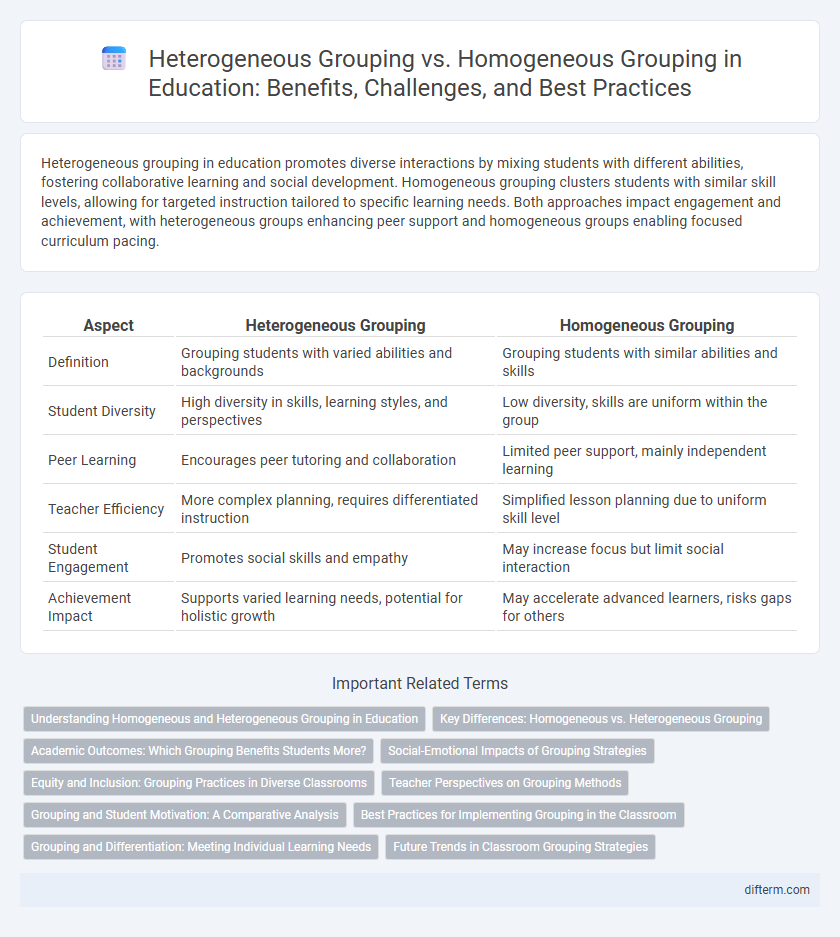Heterogeneous grouping in education promotes diverse interactions by mixing students with different abilities, fostering collaborative learning and social development. Homogeneous grouping clusters students with similar skill levels, allowing for targeted instruction tailored to specific learning needs. Both approaches impact engagement and achievement, with heterogeneous groups enhancing peer support and homogeneous groups enabling focused curriculum pacing.
Table of Comparison
| Aspect | Heterogeneous Grouping | Homogeneous Grouping |
|---|---|---|
| Definition | Grouping students with varied abilities and backgrounds | Grouping students with similar abilities and skills |
| Student Diversity | High diversity in skills, learning styles, and perspectives | Low diversity, skills are uniform within the group |
| Peer Learning | Encourages peer tutoring and collaboration | Limited peer support, mainly independent learning |
| Teacher Efficiency | More complex planning, requires differentiated instruction | Simplified lesson planning due to uniform skill level |
| Student Engagement | Promotes social skills and empathy | May increase focus but limit social interaction |
| Achievement Impact | Supports varied learning needs, potential for holistic growth | May accelerate advanced learners, risks gaps for others |
Understanding Homogeneous and Heterogeneous Grouping in Education
Homogeneous grouping in education involves organizing students based on similar abilities or achievement levels, which can streamline instruction and target specific skill development efficiently. Heterogeneous grouping mixes students of diverse abilities and backgrounds, promoting peer learning, collaboration, and social interaction that can enhance critical thinking and empathy. Research shows that heterogeneous groups often improve overall learning outcomes by balancing challenges and support within the classroom environment.
Key Differences: Homogeneous vs. Heterogeneous Grouping
Homogeneous grouping in education organizes students by similar ability levels, enabling targeted instruction and efficient pacing, which often boosts mastery of specific skills. In contrast, heterogeneous grouping combines diverse learners with varying abilities, promoting peer learning, collaboration, and social development through exposure to multiple perspectives. Key differences include the impact on student engagement, differentiation strategies, and potential effects on self-esteem and academic achievement.
Academic Outcomes: Which Grouping Benefits Students More?
Heterogeneous grouping fosters diverse skill sets and promotes peer learning, often resulting in improved critical thinking and collaboration skills among students. Homogeneous grouping allows for tailored instruction at similar academic levels, which can accelerate learning for advanced students but may limit exposure to varied perspectives. Research indicates that balanced heterogeneous groups generally enhance overall academic outcomes by supporting both struggling and advanced learners through mutual engagement.
Social-Emotional Impacts of Grouping Strategies
Heterogeneous grouping fosters diverse social interactions that enhance empathy, collaboration, and emotional intelligence by exposing students to varied perspectives and abilities. Homogeneous grouping can increase students' confidence and sense of belonging by aligning peers with similar skill levels but may limit opportunities for social-emotional growth and adaptability. Research indicates heterogeneous groups contribute to stronger social skills development and reduced stereotyping, while homogeneous groups often emphasize academic achievement at the potential cost of emotional resilience.
Equity and Inclusion: Grouping Practices in Diverse Classrooms
Heterogeneous grouping promotes equity and inclusion by mixing students of varying abilities, backgrounds, and learning styles, fostering collaborative learning and peer support. This practice reduces achievement gaps and encourages diverse perspectives, essential for cultivating an inclusive classroom environment. Conversely, homogeneous grouping risks reinforcing disparities by isolating students based on skill levels, potentially limiting access to diverse social interactions and equitable learning opportunities.
Teacher Perspectives on Grouping Methods
Teachers perceive heterogeneous grouping as a strategy that fosters diverse perspectives and peer learning, enhancing critical thinking and social skills among students. Conversely, homogeneous grouping is valued for its ability to target instruction more precisely based on similar skill levels, allowing educators to tailor lessons and pace effectively. Both methods present unique challenges and benefits, with teachers often balancing group composition to optimize engagement and academic outcomes.
Grouping and Student Motivation: A Comparative Analysis
Heterogeneous grouping in education promotes diverse skill sets and perspectives, enhancing student motivation through collaborative learning and peer support. Homogeneous grouping allows targeted instruction tailored to similar ability levels, which can increase motivation by reducing frustration and fostering mastery. Research indicates that heterogeneous groups often boost social motivation, while homogeneous groups can improve academic confidence, highlighting the need to balance both approaches for optimal student engagement.
Best Practices for Implementing Grouping in the Classroom
Effective implementation of heterogeneous grouping in the classroom promotes diverse skill sets and peer learning, enhancing critical thinking and collaboration among students of varying abilities. Best practices include clearly defining group roles, employing formative assessments to balance group composition, and rotating groups regularly to maximize social interaction and exposure to different perspectives. Homogeneous grouping can be strategically used for targeted interventions or advanced enrichment, ensuring instructional methods are tailored to specific learning needs while avoiding long-term tracking that limits student growth.
Grouping and Differentiation: Meeting Individual Learning Needs
Grouping students heterogeneously promotes diverse skill levels and perspectives, fostering peer learning and collaboration essential for differentiated instruction. Homogeneous grouping allows teachers to tailor content more precisely to students' similar readiness levels, enabling targeted interventions and accelerated learning. Effective differentiation relies on balancing both grouping strategies to address individual learning needs and optimize academic growth.
Future Trends in Classroom Grouping Strategies
Future trends in classroom grouping strategies emphasize dynamic approaches that blend heterogeneous and homogeneous grouping to enhance personalized learning and student engagement. Data-driven tools and AI-powered platforms enable educators to tailor group compositions based on individual strengths, learning styles, and social-emotional needs. This shift fosters collaborative problem-solving and maximizes academic growth by leveraging diverse skill sets within adaptive learning environments.
heterogenous grouping vs homogenous grouping Infographic

 difterm.com
difterm.com